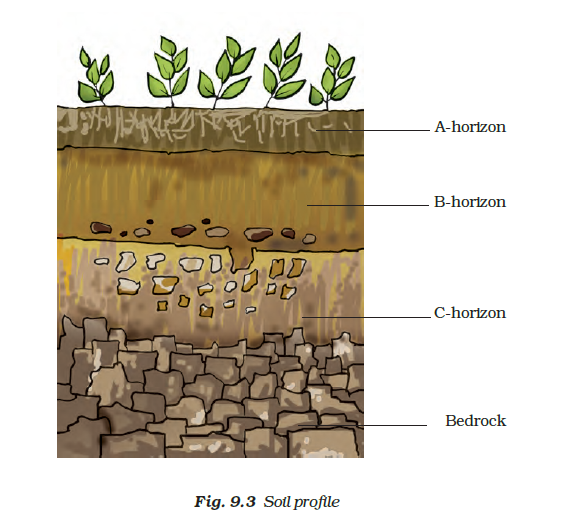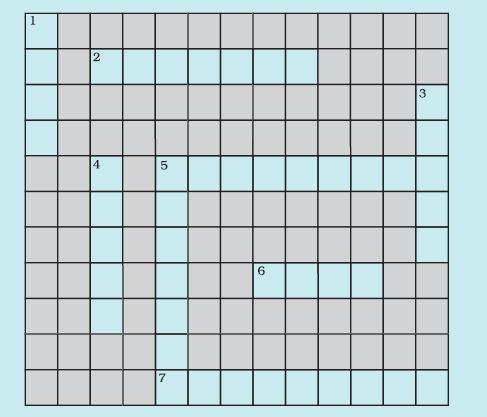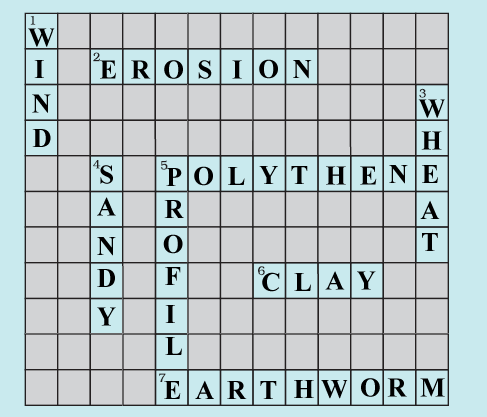NCERT Solutions Class 7 Science
The NCERT Solutions in English Language for Class 7 Science Chapter – 9 (Soil) has been provided here to help the students in solving the questions from this exercise.
Chapter – 9 (Soil)
Tick the most suitable answer in questions 1 and 2.
1. In addition to the rock particles, the soil contains
(i) air and water
(ii) water and plants
(iii) minerals, organic matter, air and water
(iv) water, air and plants
Answer – (iii) minerals, organic matter, air and water.
2. The water holding capacity is the highest in
(i) sandy soil
(ii) clayey soil
(iii) loamy soil
(iv) mixture of sand and loam
Answer – (ii) clayey soil
3. Match the items in Column I with those in Column II:
| Column – I | Column – II |
| (i) A home for living organisms | (a) Large particles |
| (ii) Upper layer of the soil | (b) All kinds of soil |
| (iii) Sandy soil | (c) Dark in colour |
| (iv) Middle layer of the soil | (d) Small particles and packed tight |
| (v) Clayey soil | (e) Lesser amount of humus |
Answer –
| Column – I | Column – II |
| (i) A home for living organisms | (b) All kinds of soil |
| (ii) Upper layer of the soil | (c) Dark in colour |
| (iii) Sandy soil | (a) Large particles |
| (iv) Middle layer of the soil | (e) Lesser amount of humus |
| (v) Clayey soil | (d) Small particles and packed tight |
4. Explain how soil is formed.
Answer – Soil is formed through the process of weathering. Weathering is a process of physical breakdown and chemical decomposition of rocks and minerals near or at the surface of the earth. This physical and chemical decomposition is primarily done by wind, water, and climate. As a result of these processes, large rock pieces are converted into smaller pieces and eventually to soil.
5. How is clayey soil useful for crops?
Answer – Due to the very small size of the particles of clayey soil, particles are packed tightly and therefore can retain water. Clayey soil is also rich in organic matter. For growing crops such as wheat, gram, and paddy, the soil that is good at retaining water and rich in organic matter is suitable. Therefore, clayey soils having these characteristics are useful for such kind of crops.
6. List the differences between clayey soil and sandy soil.
Answer –
| Clayey Soil | Sandy Soil |
| 1. Particles are finer | Particles are larger |
| 2 Particles are tightly packed | Particles are loosely packed |
| 3. Holds a good amount of water | Water holding capacity is low |
| 4. It is heavy in weight | It is light in weight |
| 5. Rich in humus and organic nutrients | Not rich in humus and organic nutrients |
| 6. Very little air is trapped between the particles | More air is trapped between the particles |
7. Sketch the cross-section of soil and label the various layers.
Answer –

8. Razia conducted an experiment in the field related to the rate of percolation. She observed that it took 40 min for 200 mL of water to percolate through the soil sample. Calculate the rate of percolation.
Answer – Amount of water = 200 ml
Percolation time = 40 minutes
Percolation rate = (amount of water in ml) / (percolation time in minutes)
= 200 ml / 40 mins
= 5 ml / min
9. Explain how soil pollution and soil erosion could be prevented
Answer – Soil pollution can be controlled by the following measures:
- By reducing the use of plastics, we can reduce soil pollution.
- By controlling the use of chemical fertilisers and pesticides, we can control soil pollution.
Soil erosion can be controlled by taking the following steps
- Planting more and more trees will result in the reduction of soil erosion.
- By stopping deforestation and avoiding overgrazing of animals.
10. Solve the following crossword puzzle with the clues given:
| Across | Down |
| 2. Plantation prevents it. |
1. In desert soil erosion occurs through. |
| 5. Use should be banned to avoid soil pollution. |
3. Clay and loam are suitable for cereals like. |
| 6. Type of soil used for making pottery. |
4. This type of soil can hold very little water. |
| 7. Living organism in the soil. |
5. Collective name for layers of soil. |

Answer –
| Across | Down |
| 2. Plantation prevents it. – Erosion |
1. In desert soil erosion occurs through. – Wind |
| 5. Use should be banned to avoid soil pollution. – Polythene |
3. Clay and loam are suitable for cereals like. – Wheat |
| 6. Type of soil used for making pottery. – Clay |
4. This type of soil can hold very little water. – Sandy |
| 7. Living organism in the soil. – Earthworm |
5. Collective name for layers of soil. – Profile |


Leave a Reply